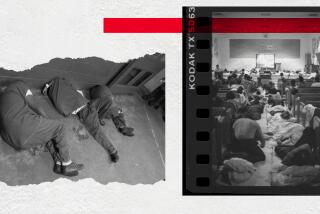Force Fields Replace Walls, ‘Pens’ Protect Guards : Prison Construction Adopts High-Tech
- Share via
LOS ANGELES — If today’s architects have their way, prisons with clanking rows of cellblocks and grizzled guards will fade into pages of history.
State and federal prisons, which house nearly 500,000 people, may never become Holiday Inns, but they could come to resemble life locked aboard the Starship Enterprise.
More than 100 members of Architecture for Justice, a committee of the American Institute of Architects, unwrapped a veritable arcade of high-tech hoosegow hardware recently at a Los Angeles exhibition.
The prison of the future has already seeped through the bars into the present.
Forget “The Great Escape,” tunneling out, scaling walls or sawing away iron bars. “You’re going to have to con your way out of jail now with a bribe or something. Any kind of ‘Mission Impossible’ scheme just won’t work,” said W. Gene Williams, chairman of Architecture for Justice.
Electrical Force Fields
Electrical force fields on prison perimeters that trigger elaborate beeping alarm systems are becoming standard equipment in many state and federal penitentiaries in place of expensive high walls, Williams said.
Door-control systems that signal guards with flashing red and green lights as to what cells are open or closed are also being installed.
Then, there are special electronic-coded cards, complements of Folger Adams Co. in Lemont, Ill., which record on commuter how often and the precise times a guard has checked on an inmate.
“That way, if there’s a suicide, and it results in a lawsuit, the prison will have the commuter printout to prove that guards checked on the inmate and there wasn’t negligence,” said Allen Patrick, an Atlanta architect and vice chairman of the committee.
For $15,000 to $25,000, a prison can buy itself a 110 Chopper Alert System from Bird-Eye Security International in Hackensack, N.J.
This piece of surveillance equipment, once only the domain of the military, comes with sensors that are spread around the prison and a control panel. If a helicopter tries to swoop down to fetch a grateful inmate in the prison yard, buttons blink, sirens ring and the radar-like gadget flashes the exact location of the intruding copter.
“We’re going to be dealing with terrorists invading our jails soon,” Bird-Eye President Victor Plessner said. “This gives us that time to intercept. We’re dealing in the seconds business.”
Protections for Teachers
Invented by NASA to protect teachers in the ghetto, the Scan 1000, one of 35 exhibits on display at the convention, is now commonplace at many prisons.
The device looks like a steel fountain pen with a cocked alarm mounted on it. The guard carries it in a shirt pocket. If he is jumped by an inmate or sees the need for reinforcement to break up a riot, he merely slaps his chest, setting off the alarm, and guards in the main control room are notified as to the exact location of the fallen guard.
“We’ve also experimented with robots that replace prison custodians, but that didn’t prove very effective,” Williams said.
More to Read
The biggest entertainment stories
Get our big stories about Hollywood, film, television, music, arts, culture and more right in your inbox as soon as they publish.
You may occasionally receive promotional content from the Los Angeles Times.










